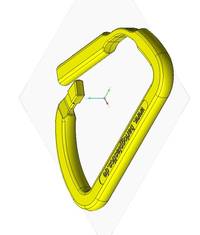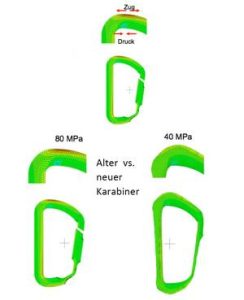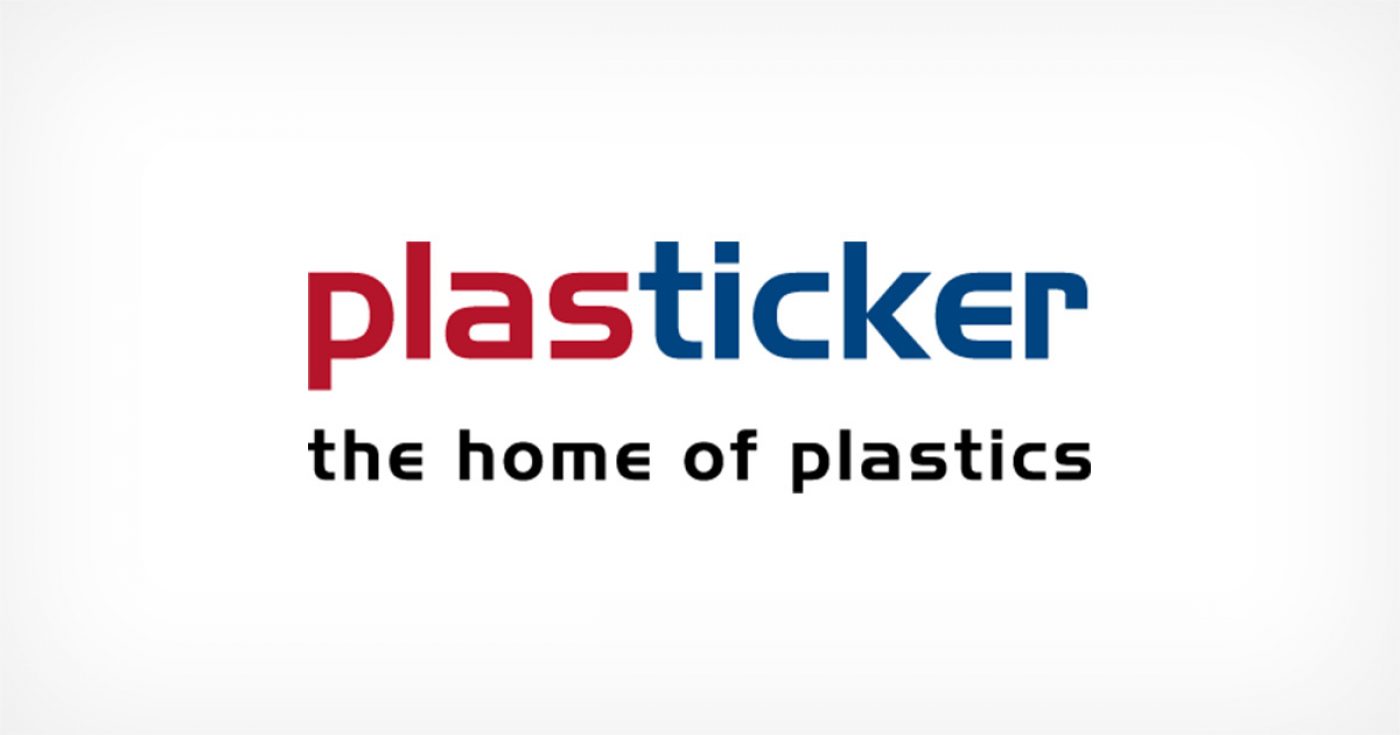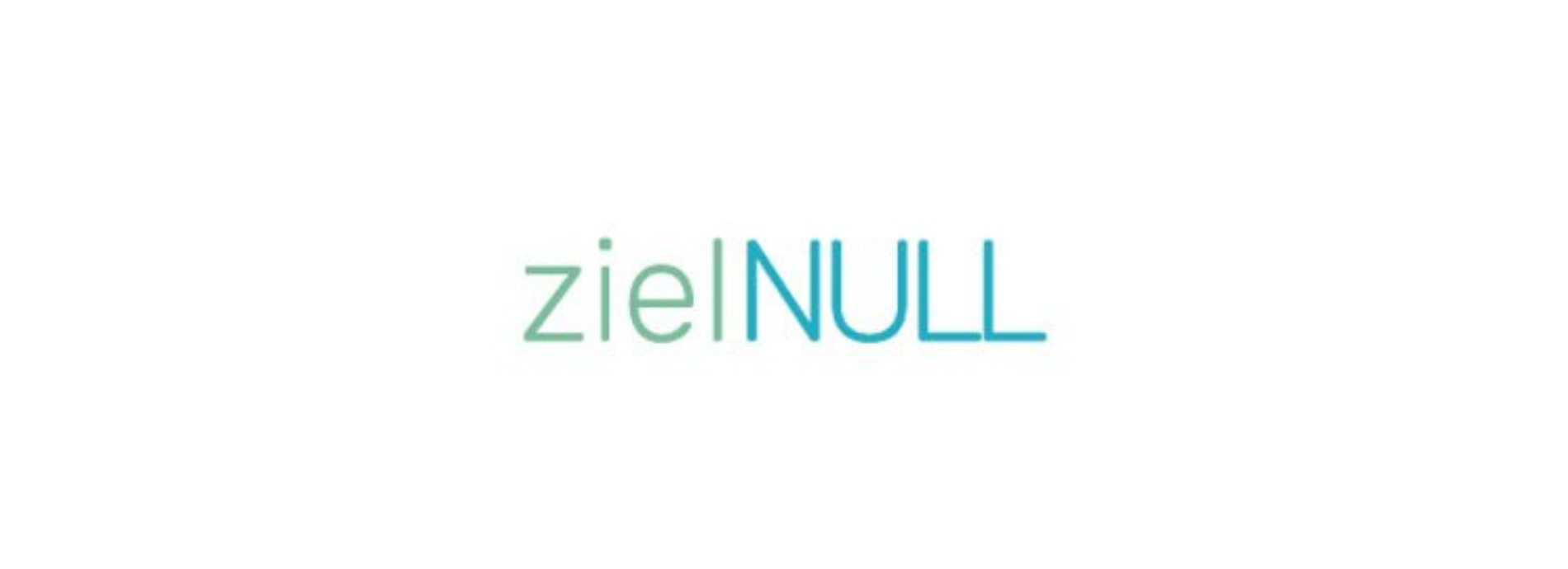Lightweight plastic carabiner – “carb-biner and carabiner 2.0” technology carrier
Lightweight = Material + Design + Process
Plastics are the predestined materials for the challenge of lightweight construction. Their low density, coupled with the design freedom and cost-effectiveness of the injection molding process, enables the production of cost-effective large series with materials that are tailored to the specific requirements of the component function.
Knowledge of the potentials, but also the weaknesses, of modern plastic materials is only part of a successful lightweight solution. The more demanding the task, the greater the importance of a design suitable for plastics and the optimum use of the available manufacturing technologies.
Carabiner = technology carrier for intelligent lightweight solutions

Snap hooks for transporting light loads, so-called material snap hooks, are today usually made of steel or aluminum. It is therefore obvious to aim for a significant weight reduction by using lightweight plastics. The technical challenge, however, lies in the additional functional integration of the gate. Here, the mechanical strength of the karabiner has to be achieved by using a high-strength but brittle carbon fiber-reinforced plastic, while at the same time integrating a spring element that requires a breaking elongation of more than 10% at full deflection.

The solution to this challenge lies in the use of sandwich technology, a special type of multi-component injection molding. Here, a flexible plastic (e.g. the POM KEBAFORM C90.0, colored red in the picture) is first injected into the mold. Then, during the injection process, a valve is actuated to clear the way for a second, high-strength material (e.g. the carbon fiber-reinforced POM KEBAFORM C902CF, colored black in the picture).
Due to the rheology, i.e. the flow behavior of the viscous plastic melts, the material injected first forms the outer component and the following material the inner component.
The material pairing produced has several advantages at once. The carbon fiber reinforced material forms an extremly stiff and strong core that absorbs the mechanical loads of the material carabiner. In the area of the spring element, this material is very close to the neutral bending line and therefore experiences only slight elongation.The flexible, unreinforced material forms a closed outer skin which, on the one hand, enables good surface quality with free coloring and, on the other hand, reproduces the highly stretched edge areas of the spring element with high elongation.In this way, the combination of completely different material properties in one component is achieved in just one operation in injection molding production, thus enabling several functions to be integrated and assembly processes to be saved.
In the area of the spring element, this material is very close to the neutral bending line and therefore experiences only slight elongation.The flexible, unreinforced material forms a closed outer skin which, on the one hand, enables good surface quality with free coloring and, on the other hand, reproduces the highly stretched edge areas of the spring element with high elongation.In this way, the combination of completely different material properties in one component is achieved in just one operation in injection molding production, thus enabling several functions to be integrated and assembly processes to be saved.
The result: 60% weight reduction compared to conventional material carabiners
The intelligent combination of two materials in a multi-component injection molding process creates an extraordinary product. With a total weight of only 9 grams, the carb-biner is approx. 60% lighter than a conventional material carabiner and achieves a maximum load of over 80 kg.
Bionics: What we can learn from nature for lightweight construction
BARLOG Plastics’ application technology experts use the methods and findings of bionics to develop customized solutions for industry requirements. Bionics deals with the transfer of phenomena from nature to technology. Applying the principles of nature’s growth laws to the optimization of component designs by means of finite element analysis (FE analysis) yields uniformly loaded structures with minimal material input.
The carabiner 2.0
From the point of view of bionics, we took another look at the Carb-Biner. The aim was to achieve a higher maximum load with the same or lower material input.

To this end, the weak points of the carb-biner were first defined in the test laboratory. This enabled the product developers to improve the carbine step by step using bionics and computer-aided engineering methods. As in nature, the material was thinned out in areas subject to low stress and reinforced in areas subject to high stress. As a result, the 2.0 carabiner has twice the load-bearing capacity of its predecessor, while using the same amount of material. With a total weight of only 9.6 grams, it is, like its predecessor, 60 percent lighter than a conventional material carabiner made of aluminum and reaches a maximum load of over 160 kg.

More news





